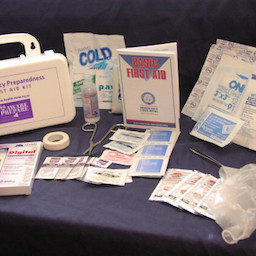A Parents Guide to First Aid

In homes where there are small children, safety is an important issue. Parents want to protect their children from all potential dangers and will most often take steps to make their home as safe an environment as possible. Unfortunately, despite one's best efforts, accidents may still happen. The National Safety Council cites injuries as the leading cause of childhood death. Of the accidents that cause these injuries, half occur in the home. When they do, parents or guardians will need to be prepared to take the necessary action. Understanding basic first aid and how to apply it according to the injury and age of the child is critical and can save the life of their child.
How to Keep Your Home Safe
Prevention is the first step that people should take in order to protect their family. There are various threats to take into consideration when making safety plans and changes to the home. To prevent poisoning, chemicals and other toxic items should be stored appropriately. Most often, this means storing them in a locked cabinet or in a location that is high enough that it is inaccessible to children. In efforts to prevent fires and burns, matches and lighters should also be kept in locations that children do not have access to. Fire and carbon monoxide detectors on every level of the home are important to warn families of fire and carbon monoxide, the latter of which has no taste or smell. In addition, parents should create fire escape plans and conduct practice drills to ensure that everyone understands what needs to be done if there is a fire. Create an emergency phone number and contact list, put on the walls, tables so that children know who to contact in the event of an emergency.
Safety & Prevention: Environmental Hazards
FEMA: Protecting Your Family From Fire
Carbon Monoxide Alarm Questions and Answers
Caring for Your Baby in a Disaster
Emergency Planning: Frequently Asked Questions
CPR + First Aid training online
How to Teach Your Child about First Aid and Emergencies
Emergencies happen, but it isn't always the child who needs emergency care. If a parent is injured, it may be the child who must administer care and contact the authorities or emergency medical services. For this reason, children should be taught basic first aid so that they know how to react in an emergency situation. These skills can also help them if they are in a situation where an adult is not readily available but immediate action is required in order to help a friend or other family member. Children should be taught what to do to stop bleeding, how to help if someone is choking or if someone has fallen and injured themselves. Parents should discuss what to do in an emergency situation and can even find useful online resources to help them teach their children.
Even before a parent teaches a child first aid, it is important that the child is taught how to call for help. All children should know how to call 911 in the event of an emergency. They should also know their full names, their parents' full names, and their address and phone number so that they are able to provide this information over the phone. Children must be taught when it is appropriate to call 911 and the importance of only calling it for emergencies.
Children Calling for Help & 911
First Aid for a New Parent
It's natural for new parents to be overly concerned when it comes to the wellbeing of their offspring. Despite the desire to prevent injuries and illness, some first-time parents don't know exactly where to begin. Babies, toddlers, and younger children are commonly injured by falls, burns and scalding. A prepared parent will know how to prevent a baby from rolling off of a surface and will have moved sharp objects out of the way when toddlers are learning to walk. A bad fall can result in trauma to the child's head and even brain injury. Infants can burn easily, even from bath water that is too hot. To prevent burns, care should be taken to ensure that temperatures are tolerable for delicate babies.
Babies also have a high risk of choking, suffocating, and drowning. Babies are at risk of falling from beds, tables, or sofas. Both babies and toddlers are known for putting items in their mouths. If an item is not approved as a toy for infants, the child may choke on it and risk suffocation. Loose buttons, marbles, and other small objects should be placed in safe locations to avoid choking or accidental suffocation. Care should also be taken to buy the appropriate type of toys. Careful parents will also want to take infant and child CPR classes. Due to their smaller frames, techniques for infant and child CPR will differ from techniques for adults. First aid classes will also provide parents with the knowledge of what to do for other types of injuries such as burns from overly hot water. Food is another area of concern for parents. Food should be properly stored and heated to prevent illness or accidental injury from heat.
Accidents to Children in Your Home: Preventing Injury
https://www.nct.org.uk/parenting/how-deal-burns-and-scalds
Mayo Clinic: Choking: First Aid
Healthy Kids Food Safety and Hygiene
We offer an online CPR course for $30 which you can complete and get certification for your workplace or your loved ones. To sign up, please click here.
Written by Grachelle Ann Ramento, RN and last updated Jul 1, 2015
Article Credit: https://www.acls.net/a-parents-guide-to-first-aid.htm


